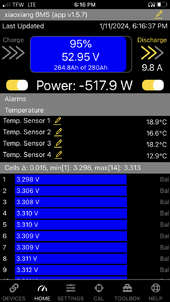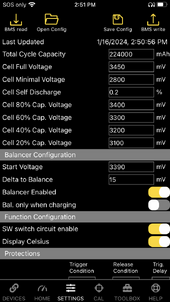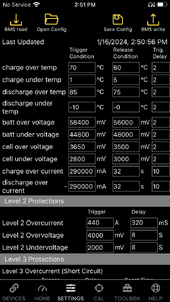n2aws
Solar Addict
- Joined
- Oct 24, 2022
- Messages
- 681
This is the point where you'll get different opinions, and as such, I'd direct you to the documentation from your cell manufacturer.awesome, just so im crystal clear:
my cell target full charge with no load should be 3.4-3.5v
unlike with lead acid batteries i don't need my charger setting 2 volts above my pack target to get there---ie---my absorb/float setting (for this one time at least) should be 54.4v.
If i set my chargers at 54.4 and im still getting cell overvolts, reduce my charger setting to whatever the battery reading happens to be when the event occurs and maintain that till my delta reaches 10 mv or below, then creep up to 54.4 in .5v increments.
As an example: The manufacturer of my battery recommends 56.8v for the pack for bulk/absorb, and float.
My batteries are 16 cells, which works out to 3.55v per cell for "normal daily" cycling. (LiFePo4 chemistry)
I personally don't like to drive my batteries that hard, after looking at some of the various charts online. So I deviate slightly.
I still have 56.8 for bulk and absorb, but 54.4 for float. This gives me a good mix of "charges up so that top balancing can occur" and "cells are at a decent resting voltage" during float.
As for your last sentence, exactly. set your charger to maintain whatever voltage triggers the warning. Then wait until the cells balance and the warning clears. Again, make sure you are doing this with *no* load on the battery. Then add maybe 0.5v, and let it balance completely again. Repeat the "raise 0.5v and let balance" step until you reach the target voltage for the pack, and it is balanced with no alarms. As a purely "these are my settings" example:
If I wanted my pack voltage to charge up to 56.8v as my battery manufacturer recommends, but they were out of balance and I get alerts at 54.2v, I would do this:
charge to 54.2, let the warning trigger.
Stay at 54.2 until the cells are balanced and warning clears.
Add 0.5v, so set to 54.7. Let the cells balance (with or without an alarm)
Add 0.5v, 55.2, let them balance (regardless of alarm)
etc etc, until I finally got to 56.8v
At each stage, let the cells balance, and if there was an alarm, wait for it to clear.







